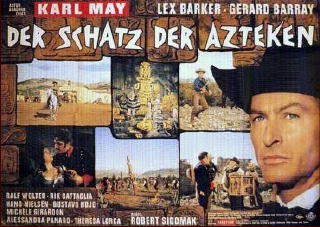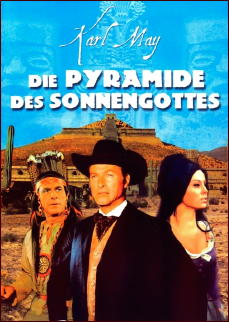December 2014
Monthly Archive
Sat 20 Dec 2014
Reviewed by JONATHAN LEWIS:

KUNG FU ZOMBIE. Eternal Film Co., Hong Kong, 1981. Original title: Wu long tian shi zhao ji gui. Billy Chong, Lau Chan, Kang-Yeh Cheng, Kei Ying Cheung, Wei Hu. Screenplay and director: Yi-Jung Hua.
Imagine you are in the process of filming a hybrid action-horror movie today. The powers that be would likely encourage you to utilize the most up-to-date CGI special effects, to procure the highest quality makeup available, and to score a memorable soundtrack. Maybe even a scene with some dark, brooding industrial dance music.
Then imagine how exceptionally polished and sleek the final product might look.
Because that’s definitely not what Kung Fu Zombie looks like. Not in the least.
Directed by Yi-Jung Hua, Kung Fu Zombie stars Indonesian-born martial arts star Billy Chong as a man caught between his domineering father, a reincarnated zombie criminal, and a kung fu kicking vampire.
It’s an absolutely silly, heaping mess of a movie, no question.
But that’s what it’s intended to be. The martial arts movie relies on slapstick comedy, bawdy humor, and (intentionally?) comical special effects to achieve something that far too many overly produced, overly computerized action films fail to do: thrill and entertain, with a tongue firmly in cheek throughout the proceedings.
I’ll confess that I have nostalgia for these types of films. You know, the ones where people fight for the sake of fighting. Where the symphony of martial arts mayhem plays on. Where villains announce their intention to kill the hero before the fighting begins.
The general public, if they ever knew him much at all, has largely forgotten Billy Chong. That’s a shame, because with his boyish charm, impish handsome looks, and quick action moves, he’s the real deal. I watched this particular Billy Chong movie on DVD, but it’s probably even better on a grainy VHS rental tape, if you know what I mean.
Fri 19 Dec 2014
Posted by Steve under
Reviews[3] Comments
IT’S ABOUT CRIME
by Marv Lachman

FRANCIS BEEDING – Death Walks in Eastrepps. Hodder & Stoughton, UK, hardcover, 1931. [Insp. Wilkins]. Mystery League, US, hardcover, 1931. Reprinted several times, including Norton, US, hardcover, 1966; Dover, US, trade paperback, 1980.
Francis Beeding’s Death Walks in Eastrepps comes well recommended. Vincent Starrett called it one of the ten best mysteries of all time when it came out, and he repeated this as late as 1965 when he did an outrageously bad introduction for a hardcover reprint in Norton’s ill-fated Seagull Library of Mystery and Suspense.

I had better document my charge. Though he doesn’t actually disclose the killer, Starrett gives away almost every other surprise. This, mind you, is not in a critical work dissecting a classic but in the introduction to a new edition that readers are presumably ready to start.
Starrett even commits a careless error, claiming that Beeding’s famous numbered series of Colonel Granby novels were published in order, e.g., The One Sane Man, The Two Undertakers, The Three Fishers, et al.

Actually, the first book in the series was The Six Proud Walkers (1928). It was followed by The Five Flamboys (1929). The One Sane Man did not come along until 1934, by which time Beeding had already used five numbers in his titles.
Just because Vincent Starrett had an off day is no reason to miss Death Walks in Eastrepps. The edition to buy and read is the brand new paperback by Dover. It has no introduction and needs none. The book speaks for itself, a throwback to a time when authors felt the need to provide mysteries that were long, inventive, and contained many surprises.
A series of murders takes place in an East Norfolk resort town. The puzzle is a good one, though the identity of the killer is far from impossible to guess. Things move at a fast pace, and a bonus is the excellent description of the effect of these murders on a resort during its summer season.
— Reprinted from The MYSTERY FANcier, Vol. 5, No. 5, Sept-Oct 1981 (slightly revised).
Thu 18 Dec 2014
Posted by Steve under
Reviews[4] Comments

BARBARA & MAX ALLAN COLLINS – Bombshell. Five Star, hardcover, 2004; trade paperback, 2005.
Did you ever hear the story of how Marilyn Monroe saved Nikita Khrushchev’s life while he was making his famous visit to the US in 1959? Me neither, so either (a) it was hushed up really, really well, or (b) could it be? – in this, their latest venture into historical mystery fiction, the Collinses are completely making it all up.
As a matter of fact, it was in September of that year when I left home for college for the first time, and given that as an understandably overwhelming distraction, I simply did not remember, until reading this book, that Nikkie, as Marilyn fondly begins to call him, even went to California. His outburst of annoyance when he discovered that he was not going to be allowed to visit Disneyland, for example, must have made headlines at the time, but until I checked it out on the Internet, I wasn’t sure if it happened, or if it is only one of the totally misguided urban legends that spring up from time to time. It is not.
It is Marilyn Monroe herself who is the detective in this book, beginning when she accidentally visits one of the men’s room at Fox Studios – don’t ask, read the book – and overhears two plotters discussing their upcoming assassination attempt on the Russian leader’s life.
And of course she is the book’s star attraction all the way through, although the title may have another interpretation or two as well. The Collinses have done their homework – they always do – and that their leading character is Marilyn Monroe, full in equal measure of self-confidence and self-doubt, well, they certainly convinced me. I don’t think any male of a certain age can read this book without falling in love with her all over again.
Thu 18 Dec 2014
THE DRUMS OF JEOPARDY. Tiffany Productions, 1931. Warner Oland, June Collyer, Lloyd Hughes, Clara Blandick, Hale Hamilton, Wallace MacDonald, George Fawcett, Florence Lake, Mischa Auer. Based on the novel by Harold MacGrath. Director: George B. Seitz.

One of the oddest things about this film, a small gem in its own way, is the name of the villain played by Warner Oland: Dr. Boris Karlov. From what I gather from Wikipedia, and what the heck, I might as well quote:
“The name ‘Boris Karlov’ was used from MacGrath’s book and for the 1922 Broadway play, but by 1923 with actor Boris Karloff using the similar sounding variation, the film version renamed the character, played by Wallace Beery, ‘Gregor Karlov.’ In the 1931 film version, however, with Warner Oland playing the character, the mad scientist’s name is restored to ‘Boris Karlov,’ less than a year before Frankenstein would make Boris Karloff a household word for generations.”
The reason Dr. Karlov is the villain is because of his totally irrational and demented hatred of the men of the Petroff family, one of whom seduced his daughter, leading directly to her death by suicide. Not knowing which one, father and three sons, he vows vengeance on all of them, even to the extent of following them from Russia to the US in his determined quest for revenge.

The drums, by the way, come into play in a strange fashion. In the dead girl’s hand was found a necklace with charms in the shape of drums, with legend having it that if anyone is given one of the drums, that person will die within 24 hours.
It is a good premise for a story, and the cast goes all out with it, especially Warner Oland in an early pre-Charlie Chan role, and June Collyer as art student Kitty Conover and Clara Blandick as her aunt Abbie, whose Manhattan apartment two of the Petroff brothers have sought a safe haven in.

Fleeing further, but not out of the reach of the crazed Dr. Karlov, the fugitives head for a secluded cottage and nearby boathouse filled with spooky rooms and staircases, dank cellars and dangerous trap doors. And of course, as I recall, it was dark and stormy night.
Perhaps I should not tell you this, but the villain of piece certainly gets what’s coming to him, and more. The acting is somewhat of a drag at times, as was common in talking movies produced as early as this one, but the action is always fast and furious.
One could only wish for a better print than the one from Alpha Video that I watched, in terms of both picture and sound quality, but who’s going to spend money in restoring an old forgotten movie such as this one, no matter how fun it is to watch?
Wed 17 Dec 2014
A 1001 MIDNIGHTS Review
by George Kelley & Marcia Muller

DESMOND BAGLEY – Flyaway. Doubleday, hardcover, 1979. First published in the UK: Collins, hardcover, 1978. Detective Book Club, hardcover 3-in-1 edition [no date]. Fawcett, paperback, 1980. Also: HarperCollins, paperback, 2009, paired with Windfall, also by Bagley.
Picking the best Desmond Bagley high-adventure novel is difficult because they are of uniformly high quality; most critics agree that in the past ten years, Bagley has surpassed the old masters such as Hammond Innes and Alistair MacLean with such expert novels as The Vivero Letter (1968), set in the remote Mexican jungle; The Snow Tiger (1974), a tale of an avalanche in the mountains of New Zealand’s South Island; and The Enemy (1978), which deals with computer technology. Bagley’s novels mix carefully researched background detail with a great deal of action and momentum, involving his reader thoroughly in his adventurous plots.

Flyaway may be Bagley’s finest work, a slight cut above the others. When Paul Billson disappears into the Sahara Desert,aircraft-industry security chief Max Stafford departs London for Africa to track Billson down. Max learns that Billson, whose father was a legendary there some decades ago, intends to clear the Billson name; the public still believes Billson’s father deliberately vanished over the Sahara so his wife could collect a fortune in insurance benefits. Max catches up with Billson — after much difficulty — but then both men find themselves hunted by forces intent on protecting the secret of Billson Sr.’s disappearance.
This novel is superior high adventure; Bagley’s attention to technical detail and his evocation of the desert milieu are impeccable. Bagley drew upon personal experience in the aircraft industry for this novel, which gives it added substance and credibility.
———
Reprinted with permission from 1001 Midnights, edited by Bill Pronzini & Marcia Muller and published by The Battered Silicon Dispatch Box, 2007. Copyright © 1986, 2007 by the Pronzini-Muller Family Trust.
Tue 16 Dec 2014
Reviewed by JONATHAN LEWIS:
DOWN IN THE VALLEY. Element Films, 2005. Edward Norton, Evan Rachel Wood, David Morse, Rory Culkin, Bruce Dern, John Diehl, Geoffrey Lewis, Elizabeth Peña, Kat Dennings. Screenplay and Director: David Jacobson.

To call Down In The Valley a contemporary Western doesn’t really do it justice. It’s a daring movie, one that both conforms to, and subverts the Western genre, all the while pretending to be a love story between a drifter and a bored, rebellious suburban teenage girl. In that sense, it mocks the audience, playing with the expectation that this is going to be just another misbegotten romance.
Sometimes the effort works extraordinarily well; others times it falls flat. Pancake flat, leaving the viewer wondering whether it was worth the time. And I grant you this: the movie doesn’t always make perfect sense. It certainly won’t appeal to all tastes.
But with beautiful cinematography, terrific acting by Ed Norton and Evan Rachel Wood, and a poignant reminder that those who stay true to the mores of the Old West simply can’t function in the contemporary West, Down In The Valley remains an overall thoughtful, if imperfect, story about the perils of taking escapism and national mythology a step too far.
Ed Norton portrays Harlan Fairfax Carruthers, a drifter working at a San Fernando Valley gas station. He says he’s got a background in ranching, is from South Dakota, and speaks with a drawl. And he says he doesn’t drive a car.
It doesn’t take much for the restless Tobe (Evan Rachel Wood) to fall for the mysterious stranger, who also takes a shine to her younger brother, Lonnie (Rory Culkin). The siblings’ stepfather (David Morse) however, doesn’t much care for Harlan. White trash loser, or something like that, is what he calls him.

Harlan’s a complicated character and we never really learn exactly who he is, or who he is supposed to be. But one thing is clear: he’s from modern suburban Los Angeles. He is definitely not a gunslinger from the Old West. Tragically, however, that is what he imagines himself to be. I say tragically, because Harlan’s flight out of reality, and into a celluloid daydream, ushers in a wave of violence and tragedy for the people with whom he comes into contact.
Norton is exceptional in his role, portrays the dangerously unstable Harlan so convincingly that one cannot imagine another actor playing this bizarre character, a man so fundamentally broken by the modern world that he chooses to live out his life as if he belonged in a dusty 1880s street, rather than in a 1970s gas station. He’s an outlaw gunslinger in a realm of jam-packed freeways, strip malls, and dingy motels.

Let me repeat: Down In the Valley doesn’t always work. For example, it sometimes makes far too much use of symbolism and metaphor when subtlety would have done the trick. Sometimes too much pop psychology isn’t good for a movie and grates on the nerves.
The movie definitely has a message, although it’s not exactly clear what it is. That the Old West was, at root, a violent society and that we shouldn’t miss its passing? That suburbanization results in alienation from nature? That society will always have drifters who pose a menace to the community?
Thankfully, the movie eschews a happy, tidy ending where everything is set aright. It leaves the viewer with a somewhat disconcerting vision of the ability of one man, one psychologically bruised, lonesome gun toting drifter, to wreak so much havoc on an already dysfunctional family. At times clichéd, others poignant, Down In The Valley is a romance, neo-noir, and Western wrapped in a character study. It’s certainly worth a look. Just don’t go into it expecting a totally coherent, flawless narrative.
Tue 16 Dec 2014
Posted by Steve under
Reviews[10] Comments

ERLE STANLEY GARDNER – The Case of the Lazy Lover. Ballantine, paperback, 1981. First published in hardcover by William Morrow, 1947. Subsequently reprinted by Pocket Books many times in paperback.
Perry Mason it was, who introduced me to “adult” mystery fiction — assuming you can exclude the inevitable batch of Sherlock Holmes stories that everybody read as a kid, didn’t you? — and I’ve had a weakness for his cases ever since. It’s been a while since I actually read one, though, so I read this one with a little bit of a question mark in my mind. Have my tastes changed? Is Gardner’s sometimes bare-boned writing style now slipped beneath me?
Nope. Not really. I notice it, his writing style, more now, and I can see more clearly what he’s doing when he does it, but I can assure you that the formula still works. I enjoyed this book, and I’m going to start reading more of them.

Start with a mystery, grab the reader’s attention right away, and don’t let go until you’re done. That was Gardner’s motto, and here’s a fine example of the kind of results you can get from that sort of story-telling philosophy.
Mason gets two checks for $2500 from the same person, previously unknown, on the same day. One proves to be a forgery. Add a possible amnesia victim. Various corporate power struggles and legal shenanigans follow. Then a murder, complete with detailed map. Perry Mason once again shows that circumstantial evidence is shown to be worth what it is, about the same as any other pack of lies. And the beginning chapter’s events are not explained until the very end.
Except for minor details and occasional changes in the law and police procedures between then and now, the Mason stories are very nearly timeless, and I’m glad to see them back in print again. [This review was written right around the time that Ballantine started their program of reprinting most, if not all of the Perry Mason novels.]
Rating: B.
— Reprinted from The MYSTERY FANcier, Vol. 5, No. 3, May/June 1981. (mildly revised).
[UPDATE] 12-16-14. I no longer feel the same way, I’m sorry to say. The formula Gardner used to wrote the Mason books, which were extremely popular when he was still writing them, has worn thin, and now 33 years later, I don’t believe there that any publisher is going to start reprinting them soon.
It isn’t so much the lack of characterization that has bothered me the last few times I’ve read a Mason story — that’s a given — but I’ve begun to believe that the intricacies of the plots don’t really stand up to close examination all that well. Or perhaps I’ve been reading from the tail end of the series. Maybe I should try choosing from the earlier books, the ones from the 30s that made Gardner’s reputation what it was from the start, and see how those read today.
Mon 15 Dec 2014
REVIEWED BY DAN STUMPF:
PARIS WHEN IT SIZZLES. Paramount, 1964. William Holden, Audrey Hepburn, Noel Coward, with appearances by Marlene Dietrich, Mel Ferrer, Frank Sinatra and Tony Curtis. Written by George Axelrod, based on the film Holiday for Henrietta (La fête à Henriette, 1952) written by Julien Duvivier and Henri Jeanson. Directed by Richard Quine.

Someone’s going to have to help me with this; I’ve seen Paris When It Sizzles a bunch of times and I still can’t figure out whether it’s a sophisticated bit of avant-garde filmmaking that slipped in under the Hollywood radar — or a complete flop.
It’s certainly a styish affair, with guest stars, location shooting in Paris and Antibes, lavish sets and two mega-stars. The photography is lush, the colors bright and the music bouncy, but at times all the Paramount splendour mitigates against the intimacy of what is essentially a two-character/one-set story.
Said story is set (unsteadily) on the premise of an overpaid, boozy, middle-aged screenwriter (guess who?) who, having run through the exorbitant fee paid him to write a screenplay, is holed up in a luxury hotel in Paris trying desperately to churn out a story. Enter Audrey Hepburn as his day-job typist tuned amanuensis and we’re launched into a knowing duologue about film theory that turns into a love story.
Only there’s a bit more to it than that; as Holden and Hepburn craft their tale, the movie suddenly turns into the film they’re writing, a slick caper-flick (starring Holden & Hepburn, natch) about international thieves, dogged cops and …
… and then we suddenly cut back to our stars in the hotel room, re-writing the story as they hedge their emotional bets, hearts on sleeves but cards close to the vest….
… and then back to the film-in-the film, as the characters flirt with danger and each other, bluffing about their motives and feelings as they get closer to the big score and the police move in on them….

I don’t know how Holiday for Henrietta (the film this was based on) handled all this, but the notion was sufficiently off-beat at the time that when Robbe-Grillet used it a few years later in Trans-Europ Express (1966) the critics called it avant-garde. Paramount was so nervous about the concept as to hold off releasing the film for two years, and when it finally escaped it was roundly razzed by critics who couldn’t resist rhyming sizzle and fizzle.
And in fact, some of the most elaborate gags in the film fall totally flat. Writer George Axelrod (The Manchurian Candidate, Will Success Spoil Rock Hunter) is wonderfully trenchant when dissecting pop culture and the movies, but someone (I hope it wasn’t he) decided to inject lethal doses of broad slapstick and overdone excess. (*)
(*) “overdone excess†Isn’t that a bit redundant? Well I’ve always felt that excess serves an aesthetic function in some movies, but you have to be careful not to overdo it.
Anyway, I should mention in passing that Tony Curtis is screamingly funny as a sulky bit-player, and though the biggest moments of Paris/Sizzles deflate themselves, the quieter bits sneak pleasantly up on one. Shaw once observed that our faults and our virtues don’t come in matched sets like bookends, and perhaps this is true of films as well as people. This film anyway.
Mon 15 Dec 2014
Posted by Steve under
Reviews[2] Comments
EMMA LATHEN – Going for the Gold. Simon and Schuster, hardcover, 1981, $11.95. Pocket, paperback, 1982.

Reading this latest adventure of banker-detective John Putnam Thatcher is something like finding yourself caught up in a huge science-fictional time warp. The Winter Olympics have always had more visual appeal than Wall Street will ever have, but to enhance it even further, Miss Lathen relates the story of a snowbound Lake Placid as it might have happened, in some alternate universe adjoining ours only tangentially.
Imagine, if you will, any or all of the following: the presence of a mad sniper who picks off a French ski-jumper in mid-air; a popular female skier who is falsely accused of taking drugs; a scandal in procurement kickbacks; and the kidnapping of the acting president of the IOC by an entourage of angry Swiss athletes.
In their anxiety to cover the inspired performance cf the U.S. hockey team, ABC-TV and all of the other real world media seem to have missed everything else that was going on!
Sloan Guaranty Trust’s greatest concern, however, is an incoming flood of counterfeit Eurochecks. Since the intricacies of the forging operation are also essential to uncovering the killer’s identity, it’s a case right down Thatcher’s alley. The rest of the proceedings are happily infused with equal doses of implausibility and déjà vu, and then laced with a good healthy belt of wry– humor, that is.
Rating: B minus.
— Reprinted from
The MYSTERY FANcier, Vol. 5, No. 3, May/June 1981. This review also appeared earlier in the
Hartford Courant (slightly revised).
Sun 14 Dec 2014
Reviewed by DAVID VINEYARD:
TREASURE OF THE AZTECS. CCC Filmkunst, West Germany, 1965. Originally released as Der Schatz der Azteken. Lex Barker, Gérard Barray, Rik Battaglia, Michèle Girardon, Alessandra Panaro, Theresa Lorca, Ralf Wolter, Jeff Corey. Based on a novel by Karl May. Director: Robert Siodmak.
PYRAMID OF THE SUN GOD. Originally released as Die Pyramide des Sonnengottes. Essentially the same credits as above. This is a single film released in two parts because of the length the way Fritz Lang did The Tiger of Eschnapur and The Indian Tomb in 1958. At heart it’s a serial with part one ending in a cliffhanger. But it isn’t two separate films, just one divided into two parts.
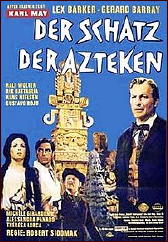
Likely you have never heard of this combined three hour epic western unless you are a fan of former Tarzan Lex Barker, German writer Karl May, noir director Robert Siodmak, screenwriter Ladislas Fodor, or German Westerns. Even then you may not have seen it because the only copies I know of are in German on YouTube.
Likely it is available in Region 2 format in German. My German is very bad, but this isn’t the type film with a great many long speeches or clever puns in it. I got by. You could get along pretty well with the sound turned off though you would miss the good score.
That’s not a knock, this one is actually quite a bit of fun if you accept it for what it is — a Technicolor wide screen serial anticipating Star Wars.
For those who don’t know, Karl May was a beloved German writer whose life included blindness, crime, and a redemption that led him to pen some of the most beloved works in German literature. He is best known for his works featuring noble Mescalero Apache chief Winnetou and his friend Old Surehand (aka Shatterhand and Firehand). Winnetou inspired so-called Indian clubs (like the Boy Scouts) all over Europe and May was the favorite writer of Albert Einstein, Albert Schweitzer, Hermann Hesse, and sad to say Adolf Hitler. May’s books are adventure stories but with a strong moral and Christian message, his most philosophical work being the allegorical novel Ardistan and Djinnistan.
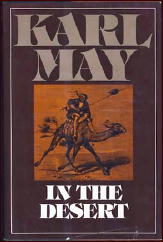
That one featured May’s other great hero, Kara Ben Nemsi, an adventurer in the Middle East, who features in five novels, beginning with In The Desert, that recount a journey to unveil a criminal conspiracy at the heart of the Ottoman Empire that starts with Kara Ben Nemsi finding a murdered man in the desert. Kara Ben Nemsi is his own Winnetou though he has a comic Arab side kick, Halef, and the comical English adventurer Sir David Lindsey in most adventures. Kara Ben Nemsi came to the screen as far back as 1920 and again in the 1950‘s. It was the early sixties before Winnetou made the leap to the big screen.
There have been several Winnitou films in the last decade, the most recent an animated version in 2009, Winnetoon (I don’t come up with them, I just report them). Kara Ben Nemsi has featured in at least two mini -series on German television.
May’s name in much of Europe was the equivalent of Jules Verne in terms of popularity and recognition. Other than Winnetou, whose cinematic adventures were often released in English with Pierre Brice in the title role and Rod Cameron, Stewart Granger, or Lex Barker as Old Surehand, it was the seventies before some of his other books came out in English here and Bantam attempted to do another Doc Savage with May’s work issuing uniform editions in paperback of Winnetou, Ardistan and Djinnistan, and In the Desert. One blurb described Kara Ben Nemsi as a cross between Superman, James Bond, and Jesus. (I thought it a bit tasteless too, but it is accurate.)
Even some May scholars aren’t sure if Old Sure Hand and Kara Ben Nemsi aren’t the same person with different names in different parts of the world. They might as well have been in the late 1960‘s because both, and Dr. Karl Sternau, the hero of these films, were being played by Lex Barker in big budget full color wide screen films. Online you can find Winnetou and In The Desert in e-book form rewritten with Old Surehand and Kara Ben Nemsi renamed Jack Hilyard in an attempt to fool American audiences. It didn’t work.

Sternau, the hero of this film is the physician to Otto von Bismark, who spent many years in Mexico and has many friends there. In the United States it is 1864, the Civil War is in full bloom, and diplomat Stenau is invited to visit the White House and President Lincoln (Jeff Corey the familiar American character actor and famed dialect coach).
Lincoln wishes to send a message of support to Mexican President Benito Juarez who is battling the French occupation of Mexico by the Emperor Maximilian backed by Louis Napoleon the Emperor of France and the French army (including the Foreign Legion though it is seldom mentioned in movies).
This much is true, Lincoln did support and sympathize with Juarez and did want the French off of this continent. Lincoln can offer Juarez nothing more than moral support because of the Civil War, but remarks to Dr. Stenau that it would aide the cause if Juarez supporters should unearth the lost treasure of the Aztecs.
Hold on, because it gets complicated from here.
Sternau travels to Mexico where he runs afoul of one of Juarez captains, a rogue Lazaro Verdoja (Rik Battaglia in a full blooded performance as the treacherous and lecherous villain). He is saved by Lt. Potaka (Gustavo Rojo) who takes him to Juarez (Fausto Tozzi). As a favor to Juarez Stenau agrees to visit wealthy ranchero owner Don Pedro Arbelez (Hans Neilson) and his daughter Rosita (Alessandro Panaro) and her companion and adopted sister, Karja (Theresa Lorca), unknown to everyone the true princess of the Aztecs and guardian of Montezuma’s treasure hidden in a live volcano as revealed to her by an ancient medicine man and the last true Aztec.
Along the way Sternau is aided by and ends up accompanied by Andreas Hassenfeffer (Rolf Walter) a traveling cuckoo salesman and the film’s comic relief (and you will need relief from him at times since his chief comic attribute is to talk incessantly) and joined by his friend American gunfighter Frank Wilson (Kelo Henderson) who falls quickly for Rosita when he saves her and Karja from hostile Indians (they don’t miss much in this one). Wilson plays with those guns to the point you may want to send him to Austria for a few sessions with Freud. He seems to find shooting at people’s feet amusing, though they do not seem to be laughing about it.
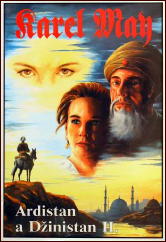
Onto the hacienda where Peroja makes a fool of himself with Rosita eventually trying to rape her and getting beaten up by Sternau just as Juarez arrives to banish him. But before that Sternau travels to Mexico City to meet Count Don Rodrigo de Rodriganda y Sevilla (Francis von Ledbedur — the real life count who played Queequeg in John Huston’s Moby Dick) and his playboy son Alfonso (Gerard Barray) fiancee of Karja.
Alfonso gets involved in a duel over a gambling debt, but his lover Josefa (Michele Giradon), an agent of French secret police leader Marshal Bazaine (Jean-Roger Caussimon), arranges for him to miss the duel and his father to go instead where he is fatally wounded.
The idea was for Alfonso to inherit the money and keep it from Juarez, but seeing what a useless playboy his son is the dying Count rewrites his will leaving the money to Juarez cause through Dr. Stenau.
We are still in part one. Still with me? I’m leaving out some minor actions scenes thrown in more to keep the film moving rather than move the plot along.
There are quite a few serial-like setbacks, advances, and adventures. Verdoja develops a hate for Sternau and Wilson, wants to to get the beautiful Rosita even more and turns mercenary for Bazaine and lover of Josefa. Alfonso betrays Sternau to Bazaine, but Hassenfeffer and Wilson save him, the little cuckoo clock salesman proving to be an excellent strategist — and in this film it is needed.
Eventually Sternau and Peroja struggle on the edge of the volcano, Sternau falls and is found by Karja and the medicine man who guides her. She insists the wounded man be taken in the treasure chamber where he briefly awakens, and she has to stop her mentor from killing him, asserting her true royal will. Instead a mystic smoke takes away his memory and heals him, and he is left to be found by Lt. Potaka as she chants her prayers to the towering gold statue of Montezuma (nothing phallic there).
End of part one and of the first book.
Pyramids of the Sun Gods starts with an impressive ten minute recap that somehow manages to hit the high points, and picks up with Sternau’s recovery as Potaka finds his body wrapped in a blanket among the bubbling fountains and flaming vents of the volcanic floor.
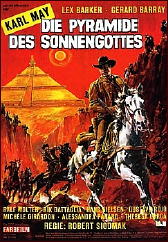
Verdoja has allied with the hostile Indians who also want Montezuma’s treasure and is having an affair with Josefa who has met her match. Meanwhile she introduces Alfonso to her scheming untrustworthy father so that just about everyone is lying to and cheating everyone else on that side of things including Verdoja and the chief of the Indians.
You won’t be able to watch this without thinking of Wagner in terms of plot and the plethora of treacherous characters all trying to stab each other in the back to the point it’s a wonder they don’t stab themselves in the back. The knife concession with this group could make you rich.
Meanwhile naive Karja tells Alfonso about Montezuma’s gold and he schemes to find it. Karja’s mentor punishes her when he learns of her mistake, but by now Alfonso has her medallion that shows the entrance to the treasure room. By now he has also double crossed Josefa’s father, who was busy double crossing her. He breaks into the volcanic hideaway and kills Karja, but not before she kills him. (It’s German, you have to expect this Wagnerian nonsense.)
That pretty much does away with the budding interest Potaka showed in her, but she never had eyes for anyone but Alfonso. Aztec princesses love a bad boy.
Back at the pyramids Verdoja and Josefa and the Indians are planning mischief and raid the hacienda killing Rosita’s father and capturing everyone else including her.
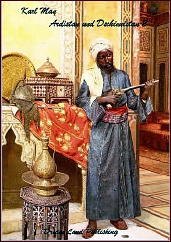
So let’s see. Lt. Potaka leads an attack on the pyramids; Verdoja threatens Rosita with a bed beneath descending spikes (I said this was serial-like) if she does not submit; a jealous Josefa comes upon them and dies under the spikes at Verdoja’s hand; the Indians who followed Alonzo return and Verdoja and the Indians leave his men in the lurch battling Potaka to steal the treasure; and Sternau, Hassenfeffer, and Wilson escape along with Josefa’s treacherous father who tells them of the treasure and where it is — he dies of course before it does him any good, it’s getting to the end and too many villains are still around to be picky — a bit like the last act of Hamlet.
Verdoja and the Indians find the treasure but as they gloat over the gold and begin to fight each other the old Indian lets loose the lava held back by a dam built by the Aztecs and it buries Verdoja alive with his gold as Sternau and the others, rather calmly all things considered, watch the volcano erupt taking its dead princess and the old medicine man and the secret of Montezuma’s gold.
I think I might have made a strategic retreat since it is entirely possible to look at the end of the film and think they are all blown to smithereens even though you know that was not the film makers’ intention.
At least I don’t think it was. Remember my German is sketchy at best.
Juarez would have to wait until 1867 to drive the French out and execute Maximilian, but he never did find the gold as you can tell by Mexico’s economic state in the years that have followed.
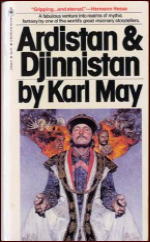
It’s just as well it ends here. Rik Battlagia’s Captain Verdoja was the most interesting and vital character, a brutal, nasty, and still rather attractive rogue compared to Barker’s stoic Dr. Sternau. I kept thinking what a good Doc Savage Barker would have made, Doc doesn’t show emotion either. He’s good in this, but his range of emotion is at best limited.
Okay, by limited I mean he smiles and frowns in the right places.
To be fair I think that was all they wanted him to do.
You’ll pardon me if I take a breath here.
I fully admit this is disjointed and confused as it sounds at times. The scenes don’t always flow smoothly, and the logic is very much like the silent German serials such as Joe May’s The Indian Tomb that inspired it. But Spain and Yugoslavia make a surprisingly good Mexico, the cinematography is first rate, the actors attractive, Barker a steadfast hero, Walter sometimes good comic relief, Lorca a busty but still young and nubile Indian princess, Giradon and Panaro attractive and good in their roles, and just about everyone acting as if they know exactly how much this was costing to make. Barker got $120,000 for the Winnetou movie The Treasure of Silver Lake, so I assume he got twice that for these two about the same time.
No wonder Barker stayed in Europe. Even as Tarzan he was never the star here he was there, and anyway he was fluent in five languages and brought up rich and sophisticated. Besides he had to pay alimony for Lana Turner and Arlene Dahl somehow along with one other, a current one, and there was one who died. Whether Jane and Cheetah got anything or not his biography doesn’t say.

I’ve had a bit a fun at the expense of this, but its a big good-natured film, and like the shaggy dog it resembles its impossible not to want to scratch it behind the ears. It’s entertaining is the best you can say for it, but that ought to be more than enough and there was no time in the movie when I smiled or laughed that I felt I was being snarky about it — I was just participating and reacting the way the film makers wanted.
If you are expecting the Robert Siodmak of Phantom Lady or The Killers you won’t find him, instead this harkens back to his early days in German cinema when he, Lang, Wilder, and others were learning their way. I would be surprised to find he or anyone involved didn’t at least enjoy the concept. It also goes back to the silent epics when Lang and others made their films epic length because if more than one film played at the same theater the take at the box-office had to be shared.
I know this being in German will put many of you off, and if you don’t understand a little of the language it will be even more daunting, but everything you really need to enjoy this is in this review or the synopsis at IMDb. It’s not a thinking man’s picture with a great deal of subtext or ur-text. I can’t imagine the screenplay for the three hour film was more than ninety pages at most. Like a Republic serial or B Western, fight scenes, good ones, take up a good deal of the running time.
So enjoy.
Of course you’ll need three hours to spare …
« Previous Page — Next Page »




